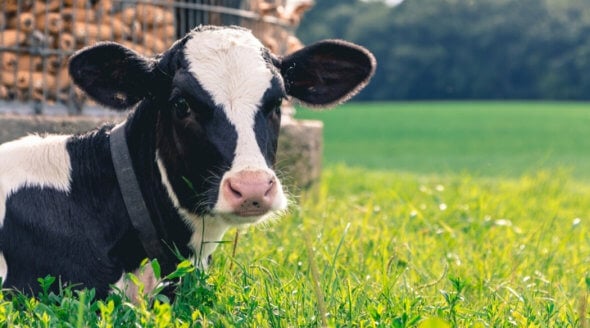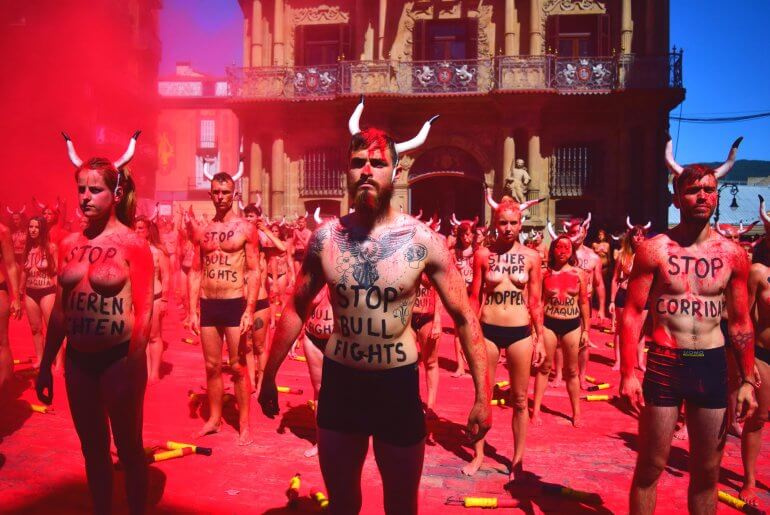Bullfighting: A Bloody Execution
Every year, at least 7,000 bulls are slaughtered in official bullfights in Spain’s bullrings. The animals are pushed to extreme mental and physical exhaustion before being stabbed to death. Bullfighting is never a fair fight but rather a ritualistic slaughter of a helpless animal.
Torture, Not Tradition
A typical Spanish bullfight starts when the bull enters the arena and the bullfighters approach him. Right from the get-go, the bullfighters push the bull to exhaustion – they chase him from one end of the arena to the other.
Once the bull is fatigued, a man on a blindfolded horse enters the arena. He drives a lance into the bull’s back, causing the animal to bleed. The blood loss is meant to frighten and weaken the bull as more men enter on foot and proceed to plunge banderillas – sticks with a harpoon point on one end – into the bull’s upper back, causing him acute pain whenever he turns his head.
The Matador, aka the Killer
When the bull is fatigued by the blood loss and the relentless harassment, the matador (which literally means “killer”) makes his final appearance. After provoking a few charges from the exhausted bull, he aims to kill him by piercing him with his sword. If the bull doesn’t die straight away, the matador will use a dagger or another weapon to sever his spinal cord and finally kill him.
If the public praises the matador’s performance enough, he might cut off the dying bull’s ears and/or tail as a trophy – sometimes while the bull is still conscious.

A Global Disgrace
Spain isn’t the only country perpetuating this kind of violence towards bulls. While the methods of torture and execution vary globally, bullfighting takes place in countries including Portugal, France, Mexico, Ecuador, Colombia, Venezuela, Peru, and parts of the United States.
The Running of the Bulls
During the annual Running of the Bulls at the San Fermín festival in Pamplona, Spain, a terrifying mob of runners (most of them tourists) chase frightened bulls about 800 metres through the streets of the city.
Panic-Stricken and Petrified
Two types of bulls are used in every morning run: castrated steers, who have been “tamed”, and the bulls who will ultimately be killed in the bullring.
Organisers imprison the bulls and steers in crowded enclosures and then release them onto the streets, occasionally prodding them with sticks. Panic-stricken, the bulls herd together to find safety with the steers, who have been trained to move the herd towards the bullring.
The animals often lose their footing around corners and crash into walls, sometimes breaking bones or injuring themselves in other ways.
The San Fermín Bloodbath
Most tourists don’t realise that bullfighters kill six bulls on each of the days that the bull runs take place. Altogether, across the entire festival, at least 48 bulls are barbarically stabbed to death.
Growing Opposition
Since 2002, PETA has been teaming up with Spanish animal rights groups to stage eye-catching protests in Pamplona, in which hundreds of activists take a stand to draw attention to the vicious cruelty of the bull runs and subsequent bullfights.
These feisty activists aren’t alone in their distaste for tormenting bulls: in 2010, the Parliament of Catalonia made the landmark decision to ban bullfighting in that region, and many Spanish and French towns are implementing bans of their own.
In every region around the world where bullfighting takes place, the majority of the local population is against it – that’s why bullfighting is in decline everywhere. PETA estimates that in 2018, at least 7,000 bulls were stabbed to death in Spanish bullrings during official bullfights, about 56% fewer than 10 years prior.
Perpetuating the Problem in Pamplona
Tourists from the UK, Australia, and other countries visit Pamplona during the San Fermín festival. Many of them are unaware that the same bulls who are chased through the streets in the morning are stabbed to death in the bullring that night.
Just by going to Pamplona during the festival, tourists are indirectly financing the torture and slaughter of bulls. Even though many visitors don’t pay to watch or participate in the bull runs, they still spend money in the city, which the local government will use to subsidise the bullfighting events.
What You Can Do
- Stay away from the San Fermin Festival in Pamplona.
- Never attend a bullfight. Tourism is one of the industry’s main excuses for carrying on with this abhorrent bloodbath. Even though most visitors who witness the cruelty of a bullfight never, ever want to see one again, by that point, the money has been paid and the damage done.
- Do not run with the bulls. Since all bulls who are chased are eventually stabbed in the bullring, participating in this cruel spectacle supports the bullfighting industry.
- Speak up. Contact the authorities and tourist boards of cities where bullfighting takes place to tell them that this blood sport is unacceptable, and inform them that you won’t visit as long as they continue to support this cruelty.
- Tell your friends. Not everyone knows that tourism helps perpetuate the bullfighting industry. Share this page on Facebook and Twitter, and if anyone you know is planning to visit a country where bullfighting takes place, discuss the issue with them.
- Visit PETA’s Action Centre to add your name to our action alerts on the issue of bullfighting.
FACTBOX
- In 2018, at least 7,000 bulls were killed in official bullfights in Spain. The number of bulls killed has been decreasing since 2007.
- Bullfights could not continue without taxpayer subsidies paid by taxpayers, which can come from the local, regional, national, and even EU government.
- Although bullfighting is banned in most countries, it’s still regularly practised in nine: Spain, Portugal, France, Mexico, Ecuador, Colombia, Venezuela, Peru, and the United States. (Even in these ones, it’s banned in certain localities.)
- People have been speaking out against bullfighting for almost 500 years: in 1567, Pope Pius V proclaimed a canonical law that made attending a bullfight a mortal sin.
- Horses are also victims of bullfighting, since the industry forces them to be a part of this bloody spectacle.


